| Part of a series on |
| Sex |
|---|
 |
| Biological terms |
| Sexual reproduction |
| Sexuality |
| Sexual system |
Sequential hermaphroditism (called dichogamy in botany) is one of the two types of hermaphroditism, the other type being simultaneous hermaphroditism. It occurs when the organism's sex changes at some point in its life.[1] A sequential hermaphrodite produces eggs (female gametes) and sperm (male gametes) at different stages in life.[2] Sequential hermaphroditism occurs in many fish, gastropods, and plants. Species that can undergo these changes do so as a normal event within their reproductive cycle, usually cued by either social structure or the achievement of a certain age or size.[3]
In animals, the different types of change are male to female (protandry or protandrous hermaphroditism), female to male (protogyny or protogynous hermaphroditism),[4] and bidirectional (serial or bidirectional hermaphroditism).[5] Both protogynous and protandrous hermaphroditism allow the organism to switch between functional male and functional female.[6] Bidirectional hermaphrodites have the capacity for sex change in either direction between male and female or female and male, potentially repeatedly during their lifetime.[5] These various types of sequential hermaphroditism may indicate that there is no advantage based on the original sex of an individual organism.[6] Those that change gonadal sex can have both female and male germ cells in the gonads or can change from one complete gonadal type to the other during their last life stage.[7]
In plants, individual flowers are called dichogamous if their function has the two sexes separated in time, although the plant as a whole may have functionally male and functionally female flowers open at any one moment. A flower is protogynous if its function is first female, then male, and protandrous if its function is first male then female. It used to be thought that this reduced inbreeding,[8] but it may be a more general mechanism for reducing pollen-pistil interference.[9][clarification needed]
- ^ "Gender-bending fish". evolution.berkeley.edu. Retrieved 2019-04-03.
- ^ Avise, John C. (2011). Hermaphroditism: a primer on the biology, ecology, and evolution of dual sexuality. Columbia University Press. ISBN 978-0231527156. OCLC 712855521.
- ^ Gemmell, Neil J.; Muncaster, Simon; Liu, Hui; Todd, Erica V. (2016). "Bending Genders: The Biology of Natural Sex Change in Fish". Sexual Development. 10 (5–6): 223–241. doi:10.1159/000449297. hdl:10536/DRO/DU:30153787. PMID 27820936.
- ^ Warner, R. R. (1975). "The Adaptive Significance of Sequential Hermaphroditism in Animals". The American Naturalist. 109 (965): 61–82. doi:10.1086/282974. S2CID 84279130.
- ^ a b Todd, E. V.; Liu, H.; Muncaster, S.; Gemmell, N. J. (2016). "Bending Genders: The Biology of Natural Sex Change in Fish". Sexual Development. 10 (5–6): 223–241. doi:10.1159/000449297. hdl:10536/DRO/DU:30153787. PMID 27820936. S2CID 41652893.
- ^ a b Avise, J.C.; Mank, J.E. (2009). "Evolutionary Perspectives on Hermaphroditism in Fishes". Sexual Development. 3 (2–3): 152–163. doi:10.1159/000223079. PMID 19684459. S2CID 22712745.
- ^ Carruth, L. L. (2000). "Freshwater cichlid Crenicara punctulata is a protogynous sequential hermaphrodite". Copeia. 2000: 71–82. doi:10.1643/0045-8511(2000)2000[0071:fccpia]2.0.co;2. S2CID 85744906.
- ^ Cite error: The named reference
Darwin-1862was invoked but never defined (see the help page). - ^ Cite error: The named reference
Lloyd-1986was invoked but never defined (see the help page).